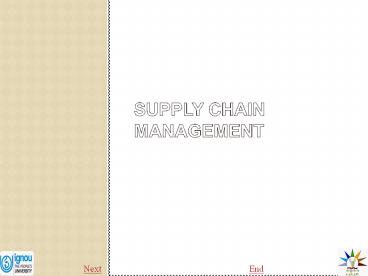SUPPLY CHAIN MANAGEMENT - PowerPoint PPT Presentation
1 / 17
Title:
SUPPLY CHAIN MANAGEMENT
Description:
Next End Supply Chain Management Definitions Supply chain management is the management of a network of interconnected businesses involved in the ultimate ... – PowerPoint PPT presentation
Number of Views:179
Avg rating:3.0/5.0
Title: SUPPLY CHAIN MANAGEMENT
1
SUPPLY CHAIN MANAGEMENT
Next
End
2
SUPPLY CHAIN MANAGEMENT
Introduction
- Supply Chain Management Definitions
- Supply chain management is the management of a
network of interconnected businesses involved in
the ultimate provision of product and service
packages required by end customers (Harland,
1996). - Importance of Supply Chain Management
- To compete in the global market and networked
economy. - Inter-organizational supply network can be
acknowledged as a new form of organization. - The network structure fits neither "market"
nor "hierarchy" categories
Next
End
Previous
3
SUPPLY CHAIN MANAGEMENT
- Evolution of Supply Chain Management Studies
- Six major movements can be observed in the
evolution of supply chain management studies - 1. Creation era
- Supply chain management was first coined by a
U.S. industry consultant in the early 1980s. - Supply chain management include the need for
large-scale changes, re-engineering, downsizing
driven by cost reduction programs.
Next
End
Previous
4
SUPPLY CHAIN MANAGEMENT
- 2. Integration era
- Development of Electronic Data Interchange (EDI)
systems in the 1960s and developed through the
1990s by the introduction of Enterprise Resource
Planning (ERP) systems. - 3. Globalization era
- The third movement of supply chain management
development, the globalization era, can be
characterized by the attention given to global
systems of supplier relationships and the
expansion of supply chains over national
boundaries and into other continents.
Next
End
Previous
5
SUPPLY CHAIN MANAGEMENT
- 4. Specialization era
- Phase I Outsourced Manufacturing and
Distribution - In the 1990s, industries began to focus on core
competencies and adopted a specialization model. - Companies abandoned vertical integration, sold
off non-core operations, and outsourced those
functions to other companies.
Next
End
Previous
6
SUPPLY CHAIN MANAGEMENT
- 5. Specialization Era
- Phase II - Supply Chain Management as a
service - Specialization within the supply chain began in
the 1980s with the inception of transportation
brokerages, warehouse management, and
non-asset-based carriers and has matured beyond
transportation and logistics into aspects of
supply planning, collaboration, execution and
performance management
Next
End
Previous
7
SUPPLY CHAIN MANAGEMENT
- Supply Chain Management Activities
- Determine channel strategy and level of
distribution intensity - Manage relationships in the supply chain
- Manage the logistical components of the supply
chain - Balance the costs of the supply chain with the
service level demanded by customer
Next
End
Previous
8
SUPPLY CHAIN MANAGEMENT
- Components of Supply Chain Management Integration
- Planning and control
- Work structure
- Organization structure
- Product flow facility structure
- Information flow facility structure
- Management methods
- Power and leadership structure
- Risk and reward structure
- Culture and attitude
End
Next
Previous
9
SUPPLY CHAIN MANAGEMENT
- Role of Supply Chain Management
- Communicator of Customer demand from point of
sale to supplier - Physical flow process that engineers the
movement of goods - Supply Chain Management and its Benefits
- Reduction of product losses in transportation
and storage. - Increasing of sales.
- Dissemination of technology, advanced techniques,
capital - and knowledge among the chain partners.
End
Next
Previous
10
SUPPLY CHAIN MANAGEMENT
Contd
- Better information about the flow of products,
markets and technologies. - Transparency of the supply chain.
- Tracking tracing to the source.
- Better control of product safety and quality.
- Large investments and risks are shared among
partners in the chain.
Next
End
Previous
11
SUPPLY CHAIN MANAGEMENT
- Supply Chain Modeling Approaches
- Network Design Methods
- Rough Cut Methods
- Simulation methods
- Critical drivers in a Supply Chain
- 1.Inventory
- 2.Transportation
- 3. Facilities
- 4. Information
Next
End
Previous
12
SUPPLY CHAIN MANAGEMENT
- Agricultural Supply Chain Management at global
level - Cross-border Supply Chain
INPUT SUPPPLIER
FARMER
AGRI INDUSTRY
RETAILER
FOOD INDUSTRY
CONSUMER
Next
End
Previous
13
SUPPLY CHAIN MANAGEMENT
- Cycle for supply chain development
AWARENESS AND RISING ACTIVITIES
TOOL AND CASE DESCRIPTIONS
INSTITUTION BUILDING
CHAIN PILOT PROJECTS
Next
End
Previous
14
SUPPLY CHAIN MANAGEMENT
- Infra Structure For Horticultural Supply Chain
Management - Cold Chain Facilities
- Industrial cold stores in the Production zones
- Refrigerated vehicles for long distance transport
- Refrigerated room in wholesale markets
- Field Heat facilities
- Product temperature upon harvest
- Major fraction of the heat load to be removed
- Influences the rate of reactions during storage
Next
End
Previous
15
SUPPLY CHAIN MANAGEMENT
- Pre-Cooling facilities
- 1.Necessary for removal of field heat
- 2.Slow down the temperature dependent metabolic
processes - 3.Ensures longer storage and better product
quality
Refrigerated Cooling
Hydro Cooling
Vacuum Cooling
Next
End
Previous
16
SUPPLY CHAIN MANAGEMENT
- Supply Chain Umbrella
- Purchasing
- Quality control
- Demand and supply planning
- Material or inventory control
- Order processing
- Production planning, scheduling and control
- Warehousing / distribution
- Customer service
Next
End
Previous
17
SUPPLY CHAIN MANAGEMENT
Let us sum Up
- India is going through a retail revolution. Food
being perishable item, for the retailer to be
successful the key is proper supply chain
management. - Planning and control, Work structure,
Organization structure, Product flow facility
structure, Information flow facility structure
Management methods, Power and leadership
structure, Risk and reward structure Culture and
attitude are the main components of supply chain
management. - Awareness and rising activities, Institution
building, Chain pilot projects, Tool and case
descriptions are the main cycle for supply chain
development. - Supply chain management help to effective
utilization of inputs and improve distribution of
output.
Previous































